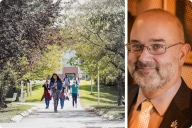You have /5 articles left.
Sign up for a free account or log in.
The innovation imperative has emerged as one of the dominant narratives in higher education.
The accepted wisdom is that higher education needs to change and that incremental advances will be inadequate to the challenges that we face.
Nowhere in higher ed is the strain of innovation talk as prominent as in the domain of learning. Attend any conference or convening that is related to the educational enterprise of universities, and you will encounter evangelists for innovation. You will hear about how the traditional system of residential courses built on seat time and the credit hour no longer meets the needs of an increasingly adult and working student population. The conversation will quickly move to demographic headwinds, unsustainable student debt and the mismatch between employer needs and institutional offerings.
Schools are told that they need to go online, go to scale and unbundle their offerings. The dominant learning innovation playbook contains elements of new delivery mechanisms (online), new partnerships (often with for-profit companies) and new markets (certificates and degrees aimed at working adults).
Prophets of learning innovation stress the need to experiment (with new complex curricula), to invest in new institutional capabilities (such as instructional design and analytics), and to enter new markets (beyond a shrinking number new high school graduates).
What is often left out of the learning innovation narrative is a discussion of the role of the faculty.
With the exception of the occasional tweet storm or latest press story about the adjunctification of higher education, rarely do we hear about how learning innovation is trying to solve the problems of faculty employment, the erosion of tenure or the future of the professoriate.
The reality of academic learning innovation is that change cannot be built on a foundation of short-term faculty contracts and punishing faculty teaching and service workloads. No professor can engage in meaningful learning innovation activities if they are unsure about where they will be teaching next year, or if they are so busy with their current responsibilities that they have no time to think.
By some estimates, non-tenure-track faculty make up almost 75 percent of faculty in higher education. Discussions of innovation that do not recognize that the majority of instruction is now delivered by faculty who are not tenured or on the tenure track are likely to arrive at ideas that are mismatched to the realities of most colleges and universities.
At best, discussions of learning innovation rarely attempt to address the challenge of the faculty labor market. At worst, non-tenure-track faculty are often excluded from engaging in learning innovation activities.
This plays out in many ways. Adjunct faculty without research budgets are often unable to attend conferences where learning innovation is discussed. If they are teaching loads of 4-4 or more, they likely do not have the time to write blog posts and articles and books about learning innovation. If they are teaching less, they’re likely working elsewhere to support themselves.
We need to create space and opportunities to diversify who is thinking and writing about learning innovation.
Perhaps more importantly, however, learning innovation needs to see the state of faculty, the adjunctification of the professoriate and the erosion of tenure as addressable, solvable problems worth exploring.
Future scholarship on learning innovation needs to explore the challenges faced by faculty throughout the entire higher ed ecosystem.
The time has come to see the realities of the faculty labor market as part of the challenge learning innovation needs to address.








